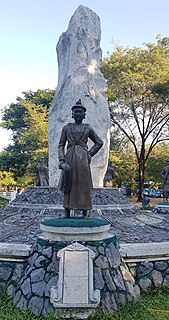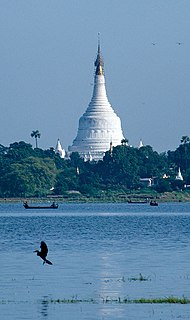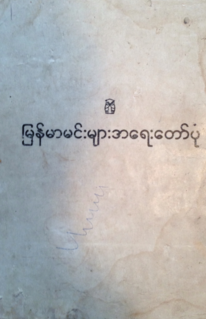| Author | Letwe Nawrahta |
|---|---|
| Original title | ဆင်ဖြူရှင် အရေးတော်ပုံ |
| Country | Kingdom of Burma |
| Language | Burmese |
| Series | Burmese chronicles |
| Genre | Chronicle, History |
Publication date | 1786–1791 |
Hsinbyushin Ayedawbon (Burmese : ဆင်ဖြူရှင် အရေးတော်ပုံ) is an 18th-century Burmese chronicle of the first four years of King Bodawpaya of Konbaung Dynasty. Despite the name Hsinbyushin, it is not the chronicle of Bodawpaya's famous brother King Hsinbyushin. [1]

The Burmese language is the Sino-Tibetan language spoken in Myanmar where it is an official language and the language of the Bamar people, the country's principal ethnic group. Although the Constitution of Myanmar officially recognizes the English name of the language as the Myanmar language, most English speakers continue to refer to the language as Burmese, after Burma, the older name for Myanmar. In 2007, it was spoken as a first language by 33 million, primarily the Bamar (Burman) people and related ethnic groups, and as a second language by 10 million, particularly ethnic minorities in Myanmar and neighboring countries.
The royal chronicles of Myanmar are detailed and continuous chronicles of the monarchy of Myanmar (Burma). The chronicles were written on different media such as parabaik paper, palm leaf, and stone; they were composed in different literary styles such as prose, verse, and chronograms. Palm-leaf manuscripts written in prose are those that are commonly referred to as the chronicles. Other royal records include administrative treatises and precedents, legal treatises and precedents, and censuses.

Bodawpaya was the sixth king of the Konbaung Dynasty of Burma. Born Maung Shwe Waing and later Badon Min, he was the fourth son of Alaungpaya, founder of the dynasty and the Third Burmese Empire. He was proclaimed king after deposing his nephew Phaungkaza Maung Maung, son of his oldest brother Naungdawgyi, at Ava. Bodawpaya moved the royal capital back to Amarapura in 1782. He was titled Hsinbyumyashin, although he became known to posterity as Bodawpaya in relation to his successor, his grandson Bagyidaw, who in turn was given this name in relation to his nephew Mindon Min. He fathered 62 sons and 58 daughters by about 200 consorts.
The chronicle covers the early reign up to 1786, and consists of 74 palm leaves with 12 lines to a leaf. It provides a detailed account of how the new capital of Amarapura was built, the 1784–1785 Arakan campaign under Crown Prince Thado Minsaw, and how the Mahamuni Buddha was brought back to Amarapura. Moreover, it includes the palace customs, including how royal appurtenances were arranged, court dresses, etc., which are not found in the main chronicles. [1]

Palm-leaf manuscripts are manuscripts made out of dried palm leaves. Palm leaves were used as writing materials in the Indian subcontinent and in Southeast Asia dating back to the 5th century BCE, and possibly much earlier. Their use began in South Asia, and spread elsewhere, as texts on dried and smoke treated palm leaves of Borassus species or the Ola leaf.

Amarapura is a former capital of Myanmar, and now a township of Mandalay city. Amarapura is bounded by the Irrawaddy river in the west, Chanmyathazi Township in the north, and the ancient capital site of Ava (Inwa) in the south. It was the capital of Myanmar twice during the Konbaung period before finally being supplanted by Mandalay 11 km north in 1859. It is historically referred to as Taungmyo in relation to Mandalay. Amarapura today is part of Mandalay, as a result of urban sprawl. The township is known today for its traditional silk and cotton weaving, and bronze casting. It is a popular tourist day-trip destination from Mandalay.

Thado Minsaw was heir-apparent of Burma from 1783 to 1808, during the reign of his father King Bodawpaya of Konbaung dynasty. As Prince of Shwedaung and Dabayin, he was entrusted by the king to manage the day-to-day affairs of the kingdom, and when necessary, to lead the Royal Army against enemies. Thado Minsaw is best known for his conquest of Arakan in 1784–1785 and the subsequent removal of Mahamuni Buddha from Mrauk-U to Amarapura. He also led the successful defense of Tenasserim (Taninthayi) coast in 1792 in the war with Siam. The crown prince also led the revitalization of Burmese theater in the late 18th century by bringing a group of young artists to his court.



